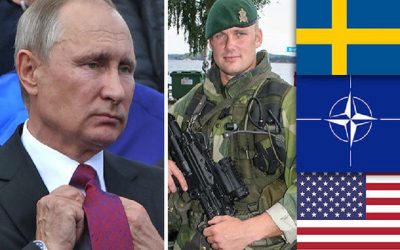Sweden Doesn’t Need to Join NATO to be a Security Threat to Russia

Sweden’s growing ties with NATO over the past half-dozen years make many observers wonder whether the Nordic country will soon join the transatlantic bloc, but it actually doesn’t even have to do so formally since it’s already a de facto member considering its close security cooperation with it, which means that Sweden is still a security threat to Russia despite not crossing Moscow’s red line of officially joining NATO.
***
Sweden’s been in popping up more frequently in international news over the past month after lawmakers approved the largest defense spending increase in 70 years on 15 December which will boost expenditures by 40% by 2025. The Hill opined that “Russia Prompts Sweden To Revive Its Defense”, while Bloomberg later reassured everyone that “Sweden’s NATO Skepticism Endures While Russia Flexes Muscles”, pointing to the fact that Swedes are pretty much evenly split between joining NATO, declining to do so, and remaining undecided. Importantly, Sweden adopted the so-called “NATO option” of neighboring Finland for the first time ever where it’ll ambiguously not rule out NATO membership sometime in the future. In possible connection with that, Sputnik reported that “’When The War Comes’ Miniseries By Swedish Armed Forces Features Russia As A Threat”, hinting that the country’s permanent military, intelligence, and diplomatic bureaucracies (“deep state”) are working hand-in-glove with the media to promote future NATO membership on an anti-Russian basis.
Nevertheless, Sweden doesn’t need to join NATO to be a security threat to Russia. As The Hill noted in its earlier cited op-ed, “Sweden and Finland not only have increasingly integrated their own forces but, as members of the European Union, have committed themselves to the defense of their EU partners, which include the three small Baltic states that border Russia. In addition, in 2014, both countries signed cooperative arrangements with NATO, permitting NATO exercises on their soil. Both participated in NATO’s 2015 Arctic Challenge exercise. Moreover, Finland and Sweden signed new agreements with the U.S. Department of Defense, which call for much closer American cooperation with each country bilaterally and, as of 2018, with both countries in a trilateral arrangement.” It also bears mentioning that Sweden pushed the factually false narrative about a so-called Russian phantom sub hunt back in 2015 that I analyzed at the time as providing the pretext for strengthening subregional military integration into what I described as the “Viking Bloc”.
This concept refers to Sweden’s leading role in organizing the anti-Russian military capabilities of “Greater Scandinavia” — itself, Norway, and Denmark (“Traditional Scandinavia”) as well as their historical-cultural partners in Finland, the Baltics, and Iceland. All but Sweden and Finland are NATO members, but the latter two’s close security cooperation with the bloc as was earlier explained makes them de facto members. As such, just like Ukraine which is also a member of “Shadow NATO” (my term for the alliance’s informal members), Sweden already represents a security threat to Russia even though it hasn’t yet and might not ever cross Moscow’s red line of formal membership. The reason for this assessment is that the bloc is clearly calling the shots when it comes to Sweden’s security strategy, relying on it to flex its historic leadership muscles to expand its “sphere of influence” throughout “Greater Scandinavia” on the pretext of helping its historical-cultural partners “defend themselves from Russian aggression”.
This is part of the larger strategy pushed by the US since 2015 which I analyzed in a January 2015 piece for Sputnik titled “Lead From Behind: How Unipolarity Is Adapting To Multipolarity”. The gist is that America realized that it’s much more financially, militarily, and organizationally efficient to delegate leadership responsibilities to its top regional allies so that they can take the lead on its behalf in pursing shared security objectives such as “containing” Russia. In the specific context of the present article, this relates to Sweden’s “Lead From Behind” role in assembling the “Viking Bloc” across “Greater Scandinavia”. Readers should be reminded that that Swedish “deep state” never forgot the Russian Empire’s victory over them in the early 18th century Great Northern War which directly led to their country’s demise as one of Europe’s Great Powers. Just like with the nearby Poles, historical memory pervades throughout all levels of its “deep state” and endured for centuries as Sweden waited for the right moment to finally take its revenge against Russia.
Sweden is striving to support NATO’s anti-Russian “containment” policy in Northern Europe despite not being a formal member of the bloc, hoping that it’ll be rewarded with American approval for its own “sphere of influence” over the lands of “Greater Scandinavia” in which its “deep state” believes that they have the historical right to exercise a form of hegemony. Truth be told, they’ll likely succeed for the most part since the smaller surrounding countries (especially the Baltics) have jumped on the anti-Russian bandwagon and are eager to receive as much military support from America’s new de facto Swedish ally as possible. They seem to hope that submitting themselves to this emerging regional order will work out to their national benefit in some way or another, perhaps economically through a “deluge” of Swedish investments after having accepted that their countries are unable to survive as truly independent states. If this growing “sphere of influence” remained economic and cultural, then it wouldn’t be a threat to Russia, but the problem is its dark military dimension.
*
Note to readers: please click the share buttons above or below. Forward this article to your email lists. Crosspost on your blog site, internet forums. etc.
This article was originally published on OneWorld.
Andrew Korybko is an American Moscow-based political analyst specializing in the relationship between the US strategy in Afro-Eurasia, China’s One Belt One Road global vision of New Silk Road connectivity, and Hybrid Warfare. He is a frequent contributor to Global Research.
Featured image is from OneWorld

